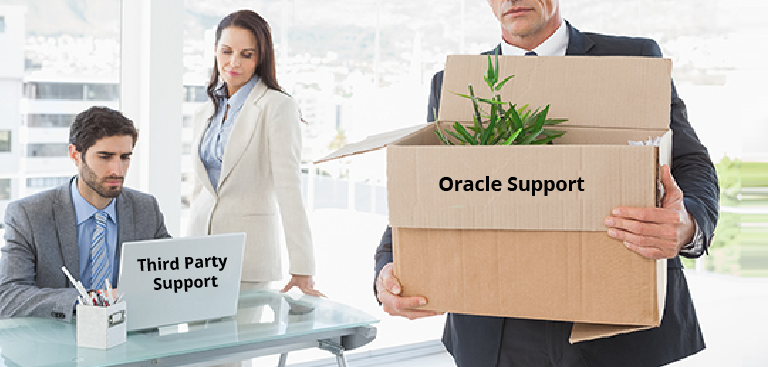Escaping Oracle Using the Power of Preparation

Meet our champion
Meet Anna Stephens (a pseudonym), who is the Head of Applications Portfolios at a large U.S. based manufacturer. Anna successfully guided her company through the shark-infested waters of Oracle support.
Why leave?
Anna’s company is using Oracle eBusiness Suite, and it also has a large Oracle database footprint. In 2015, Anna’s company took a closer look at their IT strategy. The organization wanted to ensure the money they were spending supported the business and its priorities. However, when the company calculated two key metrics, spend and yield, one IT area stood out; the spend and yield ratio for Oracle support didn’t look good.
“We realized we were paying a lot for Oracle support with very little value coming back into the business. Our investment wasn’t yielding enough return.”
Anna’s company had grown increasingly intolerant of Oracle’s engagement approach. Anna explains: “Oracle’s support model is based on tiers. Inevitably, our support incidents were assigned the first level of support; at that level, experts are not brought in to help resolve the issue.
As patches mainly drove our support pattern, sometimes Oracle could fix the problem, and sometimes they couldn’t. Regardless of the situation, Oracle’s default position was that upgrading to the latest patch set would stabilize the current version.”
In addition to beating a steady drum about updated patch sets, Oracle pushed Anna’s company to upgrade to the latest version of the application. “It felt like they were more interested in getting us to upgrade than tackling the problem,” adds Anna.
Building the case
However, Anna’s company didn’t want to upgrade. The current version of the ERP system worked well to support their business requirements. It didn’t make sense to take unnecessary risks by upgrading, then face all the stability, maintenance and support challenges that followed. To build the case, Anna conducted an ROI analysis to assess whether an upgrade was worth the effort. “After the ROI analysis was complete, we concluded the return on our support investment wasn’t worth it.”
Setting a strategy in motion
In the first phase of the strategy, Anna’s company sought to stabilize the current version of the application. “We wanted to ensure the version we were using would see us through our next five- to seven year-strategy. We planned to continue building applications in a multi-cloud environment during that time, not just Oracle cloud. The intention was to evaluate then what applications we needed to buy or build on our own or with a partner,” says Anna.
After settling on the ERP application strategy, Anna then turned her attention to the databases, approaching the problem in the same way. “In the same vein as the ERP, our first step was to ensure the version of the database we used was stable enough to see us through the next five to seven years. That would give us the leeway to make longer-term decisions about Oracle support, and at what crossroads we would need to make that decision to replace Oracle support with a third-party support vendor.”
Taking back control
The strategy Anna had set in motion was a success. “We’re now managing our infrastructure in a way that serves the business. We have a more diverse portfolio of applications that we either built, bought or partnered with a vendor to create. We use a cloud provider that gives us more autonomy to choose the cloud strategy that suits our business model, SaaS, PaaS or IaaS.”
Seizing the opportunity to change
Once Anna’s company laid out the strategy, stabilizing their existing versions of software, and putting a five to seven year roadmap in place, they felt more confident and prepared to tackle the next challenge: what to do about support. “Frankly, the quality of support we received for the money we paid wasn’t acceptable. The plan we set in motion was the opportunity we needed to explore a different support option. That’s when we started evaluating third-party support vendors.” Anna chose to work with Rimini Street as the third party support vendor.
Overcoming challenges
When an organization moves away from a large support vendor like Oracle to a smaller third-party support vendor like Rimini Street, it creates uncertainty and fear. “We anticipated our user communities would feel shocked. For years the easy path was to stay with the application developer for support; it was a safe decision. But safety and complacency are not the same things.
“The business wasn’t getting any value out of its Oracle relationship. The total experience, ROI, and capabilities didn’t justify staying. I was prepared to fight that battle because it was in the best interest of the business. I was ready to face the challenge, and I knew it had to be done strategically.”
Fear of reprisal
One of the challenges Anna had to overcome was the fear of reprisal. Oracle’s business strategy is to tie a knot around its customers through support and maintenance contracts.
“We needed to assess what, if any, legal retaliation we’d face if we severed our support ties with Oracle.”
For any company, licensing issues can be a source of concern. Hard questions needed to be asked and answered. “Had we been managing our licensing and entitlement correctly? If audited, would we be exposed? It’s not that we had been misusing or abusing our licensing, but over time, as people left the company, had they dotted the i’s and crossed the t’s?”
Poorly managed contracts are a potential pitfall. Fortunately, Anna knew exactly where the money went, and more critically, she knew what the contracts said. “We kept all the contracts in a central place; we understood how these contracts were written and their details.”
Do practice good management and governance.
Suppose you don’t have a high level of confidence in your licensing terms and conditions and usage. In that case, Oracle will respond with a licensing offensive, threatening an audit, and potentially identifying where additional licenses are in use.
The second part of that same strategy involves Oracle attaching conditions onto the use of software, i.e., you can only continue to use the software you have if you buy something additional. In both instances, the best defense is discipline. Practice good management and governance, so you are not exposed. Be ready to face an audit.
Do understand your licensing.
Complexity is Oracle’s friend. Don’t let it get the better of you. Understand what kind of licenses you’re using. Oracle has different types of licenses including code-based licenses, processor-based licenses, revenue-based licenses and concurrent-based licenses.
“If you know what you’re talking about, the LMS team will back off. For example, they came back and said we needed to have a license for Disaster Recovery (DR). I checked our contract. The new contracts may have come out with that stipulation, but my contract didn’t say that I needed to have a DR. If I have a DR, I need to have it. Until then, I’m not using it; it’s in a passive state.”
Don’t let Oracle leverage weakness.
“It’s not just the legal department that needs to understand the language of a contract. As an IT manager, if you don’t do the homework or don’t understand the contracts, that’s a problem.
Understanding the language in your contracts and how to interpret it is critical to countering Oracle’s attempts to keep you from leaving. You need to know your contracts, understand your license entitlement, usage, and capacity, in the near and long-term.
If you are confident and you understand the terms of your contract, have that conversation with your legal team to allay fears. There are plenty of well-documented examples of companies challenging Oracle successfully. Learn who they are and find out what they did.”
Fear of a catastrophic system failure
Another paralyzing fear to manage is a catastrophic system failure. “Our database is a mission-critical application that we depend on 24×7. If we dropped Oracle support, would we be able to recover our systems and resolve the issue?”
The way to crush this fear is to ensure you have a well-practiced and documented disaster recovery plan in place. Discuss and refine that DR plan with the new support vendor early on.
Do have a solid recovery plan in place.
Have a solid recovery plan in place. Work with the new third-party support vendor, acknowledging their competence and ability to provide guidance. “At the end of the day, if the worst happened, we wanted to have the vendor with the best capability of working with us to resolve the issue. If Oracle’s past performance providing support was anything to go on, it begged the question, ‘How real was that safety net’?”
Do build confidence with the executive leadership team.
Build your case and communicate with the business stakeholders and executives. “We knew we weren’t getting an acceptable ROI; we knew the state of our contracts and where we stood with our licensing and entitlements.
Internally, we led the discussions, and we conveyed that we knew what we were talking about. But that didn’t happen overnight. It took time. The CIO and I were on the same page, but that wasn’t a ticket to ride. I went through plenty of meetings and presentations to overcome the Oracle scare tactics.”
Don’t underestimate Oracle’s influence.
Oracle doesn’t like to lose contracts that are worth millions of dollars. They will use surround tactics, whittling away at other stakeholders within and outside your organization. If you have an ecosystem of suppliers and partners that depend on core systems Oracle is supporting, they’ll be knocking on those doors, peddling fear and looking for allies.
“Oracle will start influencing your customer, partner and supplier base, trying to sow fear that the versions of software being used are incompatible, prone to failure, or pose security vulnerabilities.
Don’t let that kind of tactic undermine the confidence you have in the support vendor you’re choosing. If you’ve done your homework and engaged in the conversations you need to secure the best support for the mission-critical applications that run your business, stay on track.”
Do communicate your ability.
If your ecosystem is concerned, whether at the behest of Oracle or not, let them know that you’re confident you’ve chosen the best third-party support provider and partner to support the business. If they challenge you, reassure them you’re equipped to support as you have for the last 10 or 20 years.
Fear of leaving the safe harbor
Moving away from the vendor responsible for developing the software running your business ushers in the unknown. The business leaders and the community of developers, database administrators and anyone involved in managing your Oracle system might feel like their safety net has been taken away.
Do prepare for the worst.
Prepare for the worst and hope for the best. “At the end of the day, we took a calculated risk, assessing what the maximum Oracle could come back at us with as what we might owe them. It’s like any negotiation. You have to have that figure in your head. Is that number you come up with less than the amount you’d save?”
Don’t get shackled by a false sense of security.
Acknowledge the false sense of security around you. Why do you feel more secure with Oracle? Is it based on their past experience handling your support issues?
“Our experience with Oracle support wasn’t great. Even though Oracle was the software provider, the quality of support we received was still lacking. I went as far as to start quoting our past experience facing catastrophic incidents, those times when Oracle was of no use. Gradually, people began to see how that false sense of security that had built up over time was just a veneer.”
Conduct a retrospective on historical performance, competence, ability, and knowledge; how does this experience stack up to what your new support vendor is proposing? Expect better, ask for more, create the partnership you need.
Do stand your ground.
If you aren’t prepared with details and the facts to back you up, Oracle will find your weakness and use it against you.
“It took me about six months to fully appreciate the battle that lay ahead. It’s a big decision, and I needed the unwavering support of our executive team, including the CIO and CFO. I built a solid case, collecting the evidence and the numbers to venture outside the shell. I was thorough, and we had good practices in place that were measurable.”







Leave a Comment